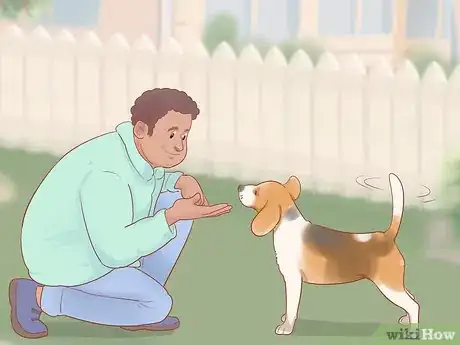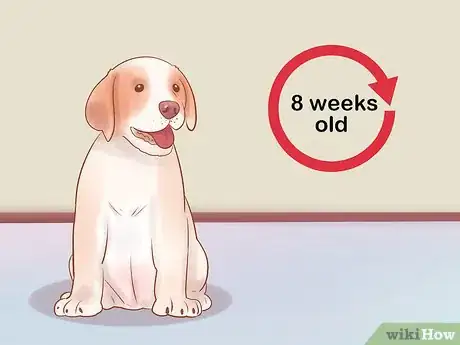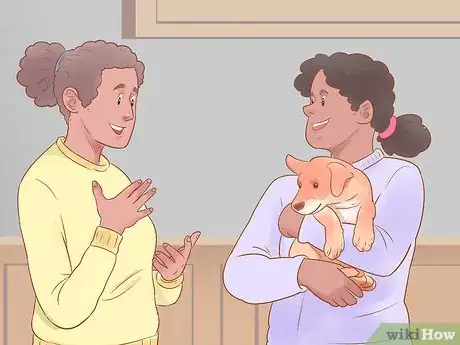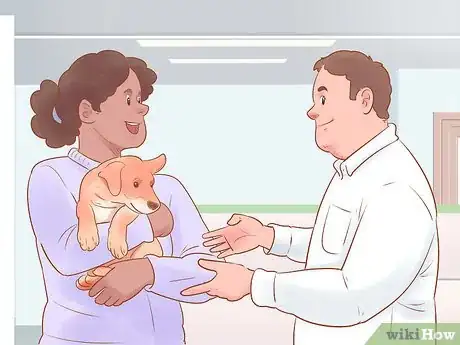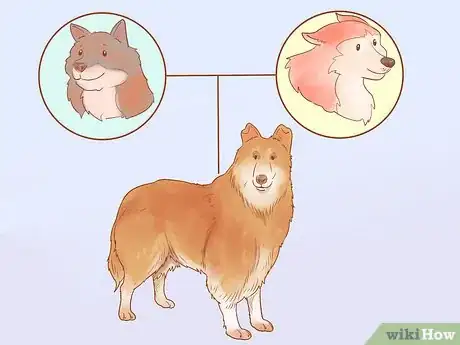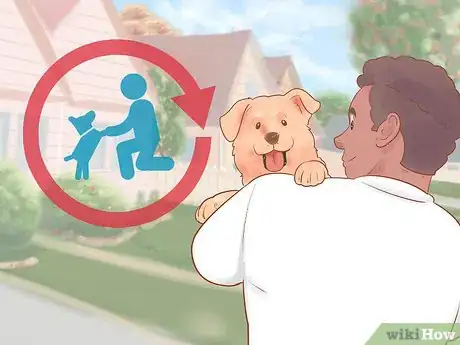This article was co-authored by Jennifer Damon. Jennifer Damon is a Professional Dog Trainer and the Owner of Love for Paws Dog Training in Richmond, VA. With over 10 years of experience training dogs, Jennifer specializes in determining the psychology that motivates dog behavior. As a supporting member of the International Association of Animal Behavior Consultants, Jennifer is passionate about improving the communication between owners and their pets through gentle, scientifically-backed methods. She holds a BFA in Communication Arts from the University of Montevallo and a Certificate in Canine Behavior Consulting from The International College of Canine Studies.
There are 26 references cited in this article, which can be found at the bottom of the page.
wikiHow marks an article as reader-approved once it receives enough positive feedback. In this case, 93% of readers who voted found the article helpful, earning it our reader-approved status.
This article has been viewed 116,440 times.
Dogs make wonderful companions and bring joy to many households. However, you have to make sure you choose the right dog for your family and lifestyle. There is a wide variety in personality, temperament, and exercise needs among the different breeds of dog. You need to take all of these considerations into account when choosing a dog to join your family.
Steps
Deciding Whether You Should Get a Dog
-
1Make sure you can keep a dog in your home.[1] If you rent from a landlord, check your lease to make sure you’re allowed to have a dog. You don’t want to end up in a situation where you either have to move or rehouse your pet because of a leasing dispute. Don’t try to “sneak” in a dog — they are impossible to hide, and you may find yourself in hot water with the landlord. Keep in mind that you may have to pay an extra pet deposit or cleaning fee to bring a dog into a rental unit.
-
2Research breed restrictions. Some areas — cities, counties, or states — ban specific breeds of dog, and you must be aware of what is or is not allowed in your region.[2] Look up “breed-specific legislation” or “dangerous dog ordinances” in your state to find out whether or not there are any restrictions on what types of dogs you can bring into your home.[3] For example, the city of Fitzgerald, Georgia allows existing pit bulls to remain in the city, but has banned owners from bringing new pit bulls into the area.[4] Contact your insurance company, as well, to see if they will make you buy additional insurance for bringing specific breeds into your home. Commonly blacklisted breeds include:[5]
- Pit Bull Terriers
- Staffordshire Terriers
- Rottweilers
- German Shepherds
- Presa Canarios
- Chows Chows
- Doberman Pinschers
- Akitas
- Wolf-hybrids
- Mastiffs
- Cane Corsos
- Great Danes
- Alaskan Malamutes
- Siberian Huskies
Advertisement -
3Take your housemates into consideration. Think about the people and other pets that you already live with. If you have a roommate or family member who is allergic to dogs, doesn’t like them, or simply does not want one, this problem will need to be resolved. Similarly, if you have other pets that are not compatible with dogs, you may not be able to provide a good home for one. Don’t bring a dog into a home where it might be met with fear or hostility.
-
4Consider how much time and energy you can devote to a dog.[6] If you work long hours with a lengthy commute, you likely won't have enough time to spend with a dog. If dogs don't get enough attention from their human “pack” members, they can become destructive or very unhappy. Attention means more than just love and affection.
- Are you able to give a dog enough exercise to keep it mentally and physically happy?
- Are you willing to wake up early to let the dog out to relieve itself?
- Does your work or lifestyle involve a lot of traveling that would take you way from the dog?
- If so, can you afford boarding costs? Do you have a friend or relative willing to watch your dog while you're away?
-
5Make sure you can afford a dog.[7] Depending on the breed you choose, your dog might live anywhere from 5 to 15 years.[8] You will have to spend money to care for your pet for the duration of its life, so make sure you can afford the investment before bringing a dog into your home.
- The ASPCA estimates that in the first year of adopting a puppy, owners of small breeds will spend around $1,314, medium-breed owners around $1,580, and large-breed owners around $1,843.[9] These costs include one-time initial veterinary care like vaccines and spaying/neutering, and the purchasing of equipment like crates, carrying bags, and leases, etc.
- After the first year, the price goes down.[10] Since you’re only paying for regular vet visits, food, toys, and licensing, owners of small dogs will pay about $580 per year, medium dogs about $695, and large dogs about $875.
Choosing a Breed
-
1Decide what size of dog you want. Once you’ve done your initial research and decided you can get a dog, you need to decide what size of dog is best for you. If you have only a small amount of space, you may not want to get a very large dog. In some cases, even apartments that allow dogs put a cap on dog size.[11] Think about what you want — a little lap dog to curl up on your legs, or a big dog to scare off potential intruders?
-
2Familiarize yourself with breed exercise needs.[12] Because dogs have been bred for wildly different purposes over the course of many centuries, they have very different exercise needs. In general, herding breeds (collies, German Shepherds), working breeds (Dobermans, Huskies) and hunting breeds (Labradors, Pointers) need a lot of exercise and room.[13] Even the smallest dogs like Maltese and Chihuahuas need some daily exercise. There are, of course, breeds known for their low exercise needs, including large dogs like Neapolitan mastiffs and small dogs like Pomeranians.[14]
- If you have an active lifestyle, you may want to choose an active breed to go on long jogs or hikes with you.
- If you prefer to curl up on the couch with a movie, choose a breed that will be content your laid back lifestyle.
-
3Consider breed temperaments.[15] A dog’s breed can have a significant impact on its personality. Some breeds, like Weimaraners, are simply too large and high-energy to have around small children — they may play too hard.[16] Others, like Akitas, have short tempers and might bite excitable children who don't know how to interact with them.[17] Research the temperaments of all the breeds you're considering to find out whether they would make a good match for your family.[18] Use the American Kennel Club or another breed registry to get an idea of each breed’s particular characteristics.[19]EXPERT TIPDavid Levin is the Owner of Citizen Hound, a professional dog walking business based in the San Francisco Bay Area. With over 9 years of professional dog walking and training experience, David's business has been voted the "Best Dog Walker SF" by Beast of the Bay for 2019, 2018, and 2017. Citizen Hound has also been ranked #1 Dog Walker by the SF Examiner and A-List in 2017, 2016, 2015. Citizen Hound prides themselves on their customer service, care, skill, and reputation.Professional Dog Walker & Trainer

 David Levin
David Levin
Professional Dog Walker & TrainerResearch the range of temperaments for each breed. Every breed of dog has a range. For example, golden retrievers have an energetic scale ranging from highly active to low energy. Once you've narrowed down the breeds you're interested in, figure out what end of the temperament range best works for you.
-
4Research each breed’s health needs.[20] Every breed of dog comes with its own set of known health problems.For example, because they have been bred to have very flat faces and bulging eyes, pugs are known to have frequent eye injuries and chronic irritation and pain.[21] The Great Dane's immense size and deep chest often causes painful bloating and twisting in the stomach that needs immediate medical care. They also suffer from hip and elbow dysplasia.[22] You have to decide if a given breed's health risks are acceptable to you.
- Because “mutts” have more genetic variation, they tend to be healthier than purebred dogs.[23] If you don’t want to deal with a high risk of genetic problems, consider avoid purebred dogs.
-
5Think about how much maintenance you can handle. Long-haired breeds like Collies may be beautiful, but they require frequent daily brushing to keep their hair free from tangles and snarls. Tangles aren't just ugly — they can turn into painful hair mats that cause pain, irritation, and even bleeding and infection.[24] Short-haired breeds will only need infrequent brushings, and might be a better choice for an owner who doesn't want to spend a lot of time on grooming.
- Consider, too, whether you're willing to clean up all the shed fur from a long-haired dog.
- The poodle is considered to be a non-shedding dog. However, it is a dog that needs frequent appointments at the groomers to keep its hair from matting.
- Other breeds also will need professional groom to maintain a proper coat.
-
6Decide whether you want a purebred or a hybrid "mutt." A purebred dog will give you a better sense of what their temperament will be like, since dogs often take after their parents. If you purchase a dog from a breeder, you’ll also have better access to the dog’s genealogy and medical history, which will help you foresee health problems. However, if you aren’t in love with a specific breed, consider adopting a dog.[25] Most of the dogs in animal rescue shelters are hybrids, or "mutts." Getting a dog from a shelter will allow you to help your community by taking responsibility for an unwanted or stray dog.
- Personnel at the rescue/humane society will usually be able to tell you about the temperaments and behaviors of individual dogs in their care. Even without breed characteristics, you should be able to get a good sense of a dog’s personality.
-
7Choose a dog of the right age. The final factor to consider before looking for a dog is whether you want a puppy, an adult dog, or an elderly dog. There are various benefits and downsides to each.
- Puppies are adorable, and can grow together with children to form memories and long-lasting friendships. They're also a lot of work at first, and require careful training to make sure they're safe to have around the house when they grow up. You'll have to deal with accidents and high energy, just like with any other baby.
- An adult dog may be difficult to break of old bad habits, but they can also come pre-house trained! They are also calmer than puppies, and won't require as much supervision.
- Elderly dogs will likely have health problems, but they can make wonderful, loving companions for elderly people or those with a sedentary lifestyle. These dogs are least likely to be adopted, so giving a home to an elderly dog would be a great service to an animal in need.
Meeting and Choosing Your Dog
-
1Meet with potential dogs. After you have done your research, you will want to meet with the dog you are considering adopting. Set up an appointment with the breeder or shelter to get to know all of the dogs you're considering. Try to gauge each dog’s personality by playing with it, walking with it, and handling it. To increase your understanding of its personality, spend as much time with the dog as possible. Don't adopt a dog that doesn't feel like a good fit. Be patient and keep looking — you'll find the right dog for you!
-
2Find out the owner’s criteria for making dogs available for adoption. In most states, puppies must be at least 8 weeks old before they can be sold or adopted, though some allow adoptions at 7 weeks.[26] If a breeder or shelter is offering a puppy below 7 or 8 weeks, they are likely not a reputable source for a pet, and should be avoided. If adopting from a shelter, make sure the staff have performed a temperament evaluation before offering a dog for adoption.
-
3Ask about each dog's behavior. Breeders and shelter attendants spend a lot of time with the animals in their care. They'll be able to tell you about the individual dog’s personality and behavior. Ask if the dog is friendly or tolerates smaller dog, cats, or other animals. Take what you learn from the dog's caretakers and combine it with your observations of the dog: does it play well, or is it aggressive toward other dogs?
-
4Make an initial evaluation of all dogs available for adoption. You may be tempted to stop and interact with the dogs at first, but make yourself observe the dogs from a distance and take notes on which ones stand out to you. On your second pass, visit with the dogs that seemed like good fits on your first pass.
- Put your hand up to the cage and see how the dog reacts. It should be eager to approach you and sniff your hand.
- Move your hand slowly back and forth. If the dog does not follow your hand, it may not be well-socialized.
- Avoid dogs that bark in your face, jump, or lunge at you.
-
5Introduce the dog to all members of the household. If you live with others — even a significant other who visits a lot — you need to make sure the dog responds well to everyone it will come into contact with. When visiting the dog, bring along other members of the household and see how they interact with it. Does anyone seem turned off by the dog’s personality? Afraid of it? All members of your little “pack” should be excited about the prospect of living together.
-
6Take special care to check the dog’s behavior with children.[27] This is especially important if you already have small children in your household, but also crucial if you plan on having children in the future. Remember that a dog might be with you for 15 years or more — don’t assume that all dogs will simply be able to adjust to the introduction of a child. If you don’t have children, ask a friend to bring their children along with you when you visit.
- Note that responsible dog-ownership means teaching children how to interact safely with dogs. It’s your job to prevent children from pulling on tails and ears or getting too close to a dog’s mouth.
- However, notice if the dog is overwhelmed by a child’s loud noises or rapid movements. If not overwhelmed, a dog’s instincts might still be triggered in an unwanted way. For example, herding breeds sometimes nip at running children’s heels, frightening them if not injuring them.[28]
-
7Inquire about the dog’s parents. If you are getting a dog from a breeder, they may actually own the parents and allow you to meet them. Most breeders will understand and accommodate such a request. Interacting with the parents will give you a way to gauge what your dog will act like as it grows up because dogs often inherit their parents' personality traits.[29]
-
8Set up a temporary foster situation if necessary. If you are unsure about whether a dog is right for you, ask to set up a temporary housing situation. This may be easier if you are adopting from a shelter than if you're buying from a breeder. A shelter may allow you to foster a dog, or even several dogs over a long period of time. This will give you time to get to know your potential pet and figure out if it's a good fit for your home, family, and lifestyle.[30]
- You should also choose a shelter with a reasonable return policy, in case you cannot keep the dog you adopt.
- Do not expect to get your adoption fee back if you return the dog, but the shelter should not refuse returns outright. Refusing to accept returned dogs suggests a shelter doesn't care enough about the lives of their animals.
Expert Q&A
-
QuestionWhat breed of dog is quiet and calm?
 Jennifer DamonJennifer Damon is a Professional Dog Trainer and the Owner of Love for Paws Dog Training in Richmond, VA. With over 10 years of experience training dogs, Jennifer specializes in determining the psychology that motivates dog behavior. As a supporting member of the International Association of Animal Behavior Consultants, Jennifer is passionate about improving the communication between owners and their pets through gentle, scientifically-backed methods. She holds a BFA in Communication Arts from the University of Montevallo and a Certificate in Canine Behavior Consulting from The International College of Canine Studies.
Jennifer DamonJennifer Damon is a Professional Dog Trainer and the Owner of Love for Paws Dog Training in Richmond, VA. With over 10 years of experience training dogs, Jennifer specializes in determining the psychology that motivates dog behavior. As a supporting member of the International Association of Animal Behavior Consultants, Jennifer is passionate about improving the communication between owners and their pets through gentle, scientifically-backed methods. She holds a BFA in Communication Arts from the University of Montevallo and a Certificate in Canine Behavior Consulting from The International College of Canine Studies.
Professional Dog Trainer There are quite a few calm breeds. For example: The Cavalier King Charles Spaniel is gentle and affectionate and known for being good with kids. They require exercise as they are a sporting breed but also like to cuddle up with you on the couch. Poodles are great because they come in a variety of sizes: toy, miniature, and standard. They are highly intelligent and friendly. The Irish Wolfhound. This dog was once bred to hunt wolves but is now known for being smart, and calm. This is a large breed they do best in a home with a yard. The French Bulldog is another quiet breed. They don’t bark much and if they do it tends to be a hoarse little whisper of a bark. They are spunky and pack a lot of fun into their pint-sized stature.
There are quite a few calm breeds. For example: The Cavalier King Charles Spaniel is gentle and affectionate and known for being good with kids. They require exercise as they are a sporting breed but also like to cuddle up with you on the couch. Poodles are great because they come in a variety of sizes: toy, miniature, and standard. They are highly intelligent and friendly. The Irish Wolfhound. This dog was once bred to hunt wolves but is now known for being smart, and calm. This is a large breed they do best in a home with a yard. The French Bulldog is another quiet breed. They don’t bark much and if they do it tends to be a hoarse little whisper of a bark. They are spunky and pack a lot of fun into their pint-sized stature. -
QuestionWhich dog breed is best for a single person?
 Jennifer DamonJennifer Damon is a Professional Dog Trainer and the Owner of Love for Paws Dog Training in Richmond, VA. With over 10 years of experience training dogs, Jennifer specializes in determining the psychology that motivates dog behavior. As a supporting member of the International Association of Animal Behavior Consultants, Jennifer is passionate about improving the communication between owners and their pets through gentle, scientifically-backed methods. She holds a BFA in Communication Arts from the University of Montevallo and a Certificate in Canine Behavior Consulting from The International College of Canine Studies.
Jennifer DamonJennifer Damon is a Professional Dog Trainer and the Owner of Love for Paws Dog Training in Richmond, VA. With over 10 years of experience training dogs, Jennifer specializes in determining the psychology that motivates dog behavior. As a supporting member of the International Association of Animal Behavior Consultants, Jennifer is passionate about improving the communication between owners and their pets through gentle, scientifically-backed methods. She holds a BFA in Communication Arts from the University of Montevallo and a Certificate in Canine Behavior Consulting from The International College of Canine Studies.
Professional Dog Trainer The best dog for a single person is an adult dog that can stand to be left alone while its owner is out and doesn’t require a lot of exercise. For most of us, work requires that we be gone for 9-10 hours per day. If you are gone that long, then I recommend you hire a dog walker or try out a doggie daycare. No matter the breed, dogs need to relieve themselves and have contact with humans or other dogs during that time for their well-being. Here are some examples of dogs who aren’t typically clingy: Shiba Inus are small, independent and almost cat-like. They are especially good for apartment dwellers. Boston Terriers are happy, fun little dogs that don’t require much grooming. Chihuahuas are also great fun and our shelters always have plenty to choose from. Havanese tends to be very sweet and are great for inexperienced dog owners.
The best dog for a single person is an adult dog that can stand to be left alone while its owner is out and doesn’t require a lot of exercise. For most of us, work requires that we be gone for 9-10 hours per day. If you are gone that long, then I recommend you hire a dog walker or try out a doggie daycare. No matter the breed, dogs need to relieve themselves and have contact with humans or other dogs during that time for their well-being. Here are some examples of dogs who aren’t typically clingy: Shiba Inus are small, independent and almost cat-like. They are especially good for apartment dwellers. Boston Terriers are happy, fun little dogs that don’t require much grooming. Chihuahuas are also great fun and our shelters always have plenty to choose from. Havanese tends to be very sweet and are great for inexperienced dog owners. -
QuestionHow many times a day should I feed a one year old Labrador?
 Pippa Elliott, MRCVSDr. Elliott, BVMS, MRCVS is a veterinarian with over 30 years of experience in veterinary surgery and companion animal practice. She graduated from the University of Glasgow in 1987 with a degree in veterinary medicine and surgery. She has worked at the same animal clinic in her hometown for over 20 years.
Pippa Elliott, MRCVSDr. Elliott, BVMS, MRCVS is a veterinarian with over 30 years of experience in veterinary surgery and companion animal practice. She graduated from the University of Glasgow in 1987 with a degree in veterinary medicine and surgery. She has worked at the same animal clinic in her hometown for over 20 years.
Veterinarian Once or twice a day. Labradors have no on / off switch when it comes to appetite. Don't be deceived into thinking your lab is hungry, because they will beg for food even straight after a large meal.
Once or twice a day. Labradors have no on / off switch when it comes to appetite. Don't be deceived into thinking your lab is hungry, because they will beg for food even straight after a large meal.
Warnings
- Avoid “backyard” breeders, who will often have very unhealthy, neglected animals.⧼thumbs_response⧽
- Be careful buying dogs over the internet. Make sure you meet the dog and the seller before buying.⧼thumbs_response⧽
- Never buy a dog on a whim. They are a large, long-term commitment and should be carefully considered.⧼thumbs_response⧽
- House-training animals is very hard. Do not give up!⧼thumbs_response⧽
- Make sure that you are aware of whether or not a puppy has had its shots.⧼thumbs_response⧽
Things You'll Need
- Crate
- Food and water dishes
- Food and water
- Toys
- Spay/Neuter (optional)
- Small breeds will sometimes need clothing (sweaters, booties, etc.)
- Larger breeds will sometimes need a car restraint for safety of the pet and driver.
- Correctly fitting collar
- Correctly fitting leash and harness
- Treats
- Doghouse
- Dog Bed
References
- ↑ http://www.nolo.com/legal-encyclopedia/smart-landlord-policies-pet-friendly-29763.html
- ↑ https://www.aspca.org/fight-cruelty/dog-fighting/breed-specific-legislation
- ↑ http://www.dogsbite.org/legislating-dangerous-dogs-state-by-state.php
- ↑ http://www.dogsbite.org/legislating-dangerous-dogs-georgia.php
- ↑ https://www.psychologytoday.com/blog/canine-corner/201405/14-dog-breeds-blacklisted-insurance-companies
- ↑ Jennifer Damon. Professional Dog Trainer. Expert Interview. 8 March 2021.
- ↑ Jennifer Damon. Professional Dog Trainer. Expert Interview. 8 March 2021.
- ↑ https://www.petcarerx.com/article/lifespan-of-a-dog-a-dog-years-chart-by-breed/1223
- ↑ https://www.aspca.org/adopt/pet-care-costs
- ↑ Sheri Williams. Certified Dog Trainer. Expert Interview. 5 June 2020.
- ↑ Jennifer Damon. Professional Dog Trainer. Expert Interview. 8 March 2021.
- ↑ Jennifer Damon. Professional Dog Trainer. Expert Interview. 8 March 2021.
- ↑ http://dogtime.com/dog-breeds/characteristics/need-for-exercise
- ↑ http://dogtime.com/dog-breeds/characteristic_lists/dont-need-tons-of-exercise
- ↑ Sheri Williams. Certified Dog Trainer. Expert Interview. 5 June 2020.
- ↑ http://www.dogreference.com/15-worst-dog-breeds-to-get-along-with-kids/
- ↑ http://www.dogreference.com/15-worst-dog-breeds-to-get-along-with-kids/3/
- ↑ http://dogtime.com/dog-breeds
- ↑ http://www.akc.org/dog-breeds/
- ↑ http://www.dogbreedhealth.com/list-of-dog-breeds/
- ↑ http://www.dogbreedhealth.com/pug/
- ↑ http://www.dogbreedhealth.com/great-dane/
- ↑ http://www.petmd.com/blogs/dailyvet/2009/August/19-4571
- ↑ http://www.dogdayafternoonspa.com/groomingservices/aboutmatting.html
- ↑ Jennifer Damon. Professional Dog Trainer. Expert Interview. 8 March 2021.
- ↑ https://www.animallaw.info/topic/table-state-laws-concerning-minimum-age-sale-puppies
- ↑ http://www.humanesociety.org/animals/dogs/tips/choosing_dog.html?referrer=https://www.google.com/
- ↑ http://www.forpaws.org/articles/children2.htm
- ↑ https://www.psychologytoday.com/blog/canine-corner/201304/does-genetics-determine-dogs-personality
- ↑ http://www.cesarsway.com/dog-rescue/adoption-tips/Before-you-adopt
- http://www.animalplanet.com/breed-selector/dog-breeds.html
About This Article
To choose a dog, get a small breed if you're looking for a cuddly lap dog, or go with a large breed if you'd prefer something that can scare off intruders. You should also take into consideration how active your lifestyle is. For example, if you love to go hiking and for long runs, an active breed, like a sheepdog or Labrador retriever, might be best for you. Also, avoid choosing a breed with long hair unless you're willing to brush it every day and take your dog to regular grooming appointments. For more tips from our Veterinary co-author, like how to choose a dog in person, scroll down!














